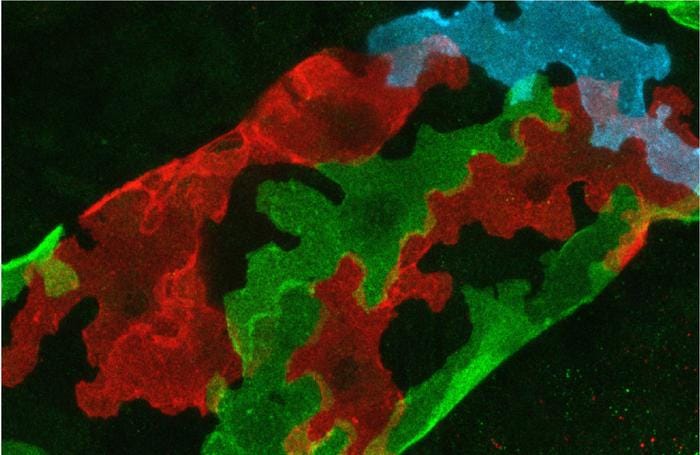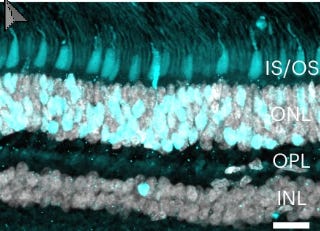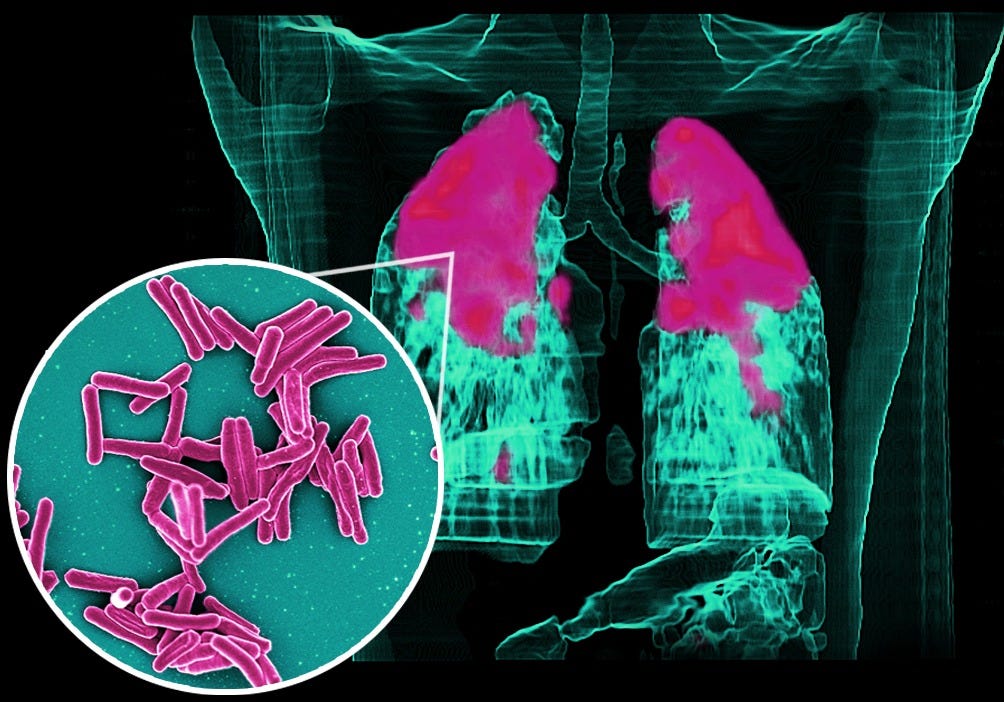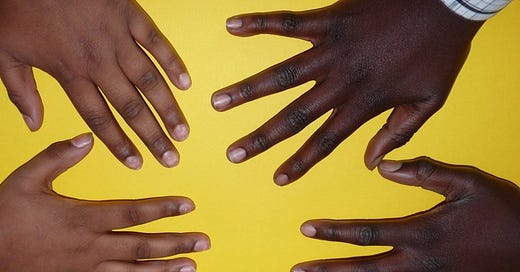Sci-Ed Update 344
Proficiency grading, deadliest infection gets worse, correcting AMD, fingernail clues, fidgeting is helpful, pregnancy toll on body, lymph vessel cell shape, artificial sweetener boosts appetite, more
Distinct Oak Leaf-Shaped Cells Support Lymph Vessels

“It has been known for a long time that capillary lymphatic endothelial cells have a lobate shape, rather like oak leaves or jigsaw puzzle pieces. However, the reason for this unique morphology was not known,” biologist Taija Mäkinen at Uppsala University remarked in a press release.
Intrigued by the shape similarities between mammalian lymphatic endothelial cells (LECs) and plant cells, Mäkinen and her colleagues sought insights from plant epidermal cells, which also endure pressure-induced strain from fluid fluxes to stay upright.
In a new study published in Nature, the researchers discovered that LECs not only share their lobate shape but also exhibit similar cytoskeletal structure and signaling pathway regulation—factors that help maintain capillary integrity.1 These findings show that this unique cellular shape is tied to an essential biological function.
Read more→ AandP.info/8f7893
Correcting the Mutation Behind a Genetic Eye Disease

Almost 200 million people worldwide suffer from macular degeneration, a condition that affects central vision and can result in near blindness.1 Although most forms of macular degeneration affect older people, those caused by mutations in a single gene are usually more severe and affected people show signs at a young age.2
Among the forms of monogenic macular degeneration, the most common is Stargardt disease. This disease is caused by mutations in the ATP-binding cassette transporter alpha 4 subunit (ABCA4) gene, giving rise to a defective protein. This eventually leads to the accumulation of toxic forms of vitamin A, causing retinal cell death. As these cells die, people gradually lose the ability to read, drive, and recognize faces.
“Because we know the genetic cause [of Stargardt disease], we felt that a new technology, base editing, could potentially [provide] hope for these patients where we can correct the underlying mutation as a therapeutic aid,” said Bence György, a translational scientist at the Institute of Molecular and Clinical Ophthalmology Basel (IOB).
Recently, György and his colleagues designed a base editing therapy that achieved high levels of mutation correction in cells, organoids, mice, and non-human primates.3 Their results, published in Nature Medicine, highlight the promise of treating certain forms of inherited blindness by addressing the root cause of the disease.
Read more→ AandP.info/3417b5
What your fingernails can reveal about your health
There's no shortage of folk wisdom about how to glean the state of your overall health from your nails, such as the pervasive idea that the white flecks that sometimes turn up – known as leukonychia – are a sign of calcium deficiency. But is there any truth to these ideas?
While the eyes might be the windows to the soul, to a doctor the nails can be the windows to your health. Physicians can use them to diagnose all sorts of conditions, from dermatological problems to kidney disease or even autoimmune disorders.
Read more→ AandP.info/34e5e5
Fidgeting at your desk? Your body may be trying to tell you something
Ever wonder why you bounce your leg, drum your fingers or click and unclick your pen until your colleagues beg you to stop?
Don't fight the fidget! It may be your body's way of telling you that "for whatever reason, you need movement right now," says Katy Bowman, a biomechanist and the author of the books Rethink Your Position and Movement Matters. So get up, switch positions, stretch or do some physical activity.
Scientific support shows it's good for our health. Fidgeting increases blood flow to our limbs, helps regulate blood sugar and reduces the risk of mortality from prolonged sitting. It can relieve stress and anxiety and improve attention, especially for some people with ADHD or other neurodivergent identities.
Kevin Patton comment→ There are often students who fidget during a lecture, video, lab activity, group discussion, etc. This annoys some of the other students—and sometimes me, too. I wonder if a class discussion of this article may help them problem-solve a class policy that serves everyone. Maybe a box of quiet fidget toys?
Read more→ AandP.info/687fca
Pregnancy’s true toll on the body: huge birth study paints most detailed picture yet
Biologists have built up one of the most detailed pictures ever of the changes that occur in women’s bodies before and after pregnancy, by pooling and studying around 44 million physiological measurements from more than 300,000 births.
The gigantic study1, which used the anonymized results of blood, urine and other tests taken before, during and more than a year after pregnancy, reveals the scale of the toll that carrying a baby and childbirth take on the body — from the myriad changes made to support a fetus to the effects of its abrupt departure from the body during birth. The research was published in Science Advances on 26 March.
The study suggests that the postnatal period in the body is much longer than people tend to assume, says Jennifer Hall, who researches reproductive health at University College London. There’s a societal expectation that you bounce back quickly after childbirth, she says. “This is like the biological proof that you don’t.”
The results also suggest that it might be possible to identify women at risk of certain common complications of pregnancy — including the blood-pressure condition pre-eclampsia and gestational diabetes — before conception. Currently, these conditions are diagnosed during pregnancy.
Read more→ AandP.info/e6c128
The World’s Deadliest Infectious Disease Is About to Get Worse

Mycobacterium tuberculosis is a near-perfect predator. In 1882, Robert Koch, the physician who discovered the microbe, told a room full of scientists that it caused one in seven of all deaths. In 2023, after a brief hiatus, tuberculosis regained from COVID its status as the world’s deadliest infectious disease—a title it has held for most of what we know of human history.
Some people die of TB when their lungs collapse or fill with fluid. For others, scarring leaves so little healthy lung tissue that breathing becomes impossible. Or the infection spreads to the brain or the spinal column, or they suffer a sudden, uncontrollable hemorrhage. Lack of appetite and extreme abdominal pain can fuel weight loss so severe that it whittles away muscle and bone. This is why TB was widely known as “consumption” until the 20th century—it seemed to be a disease that consumed the very body, shrinking and shriveling it. On a trip to Sierra Leone in 2019, I met a boy named Henry Reider, whose mix of shyness and enthusiasm for connection reminded me of my own son. I thought he was perhaps 9 years old. His doctors later told me that he was in fact 17, his body stunted by a combination of malnutrition and tuberculosis.
Read more→ AandP.info/47137e
Artificial sweetener found in diet drinks linked to brain changes that increase appetite, study finds
A growing body of evidence has increasingly linked diet sodas and other no- or low-calorie foods with weight gain — so much so that the World Health Organization issued an advisory in May 2023 saying not to use sugar substitutes for weight loss.
“Replacing free sugars with non-sugar sweeteners does not help people control their weight long-term,” Dr. Francesco Branca, director of WHO’s department of nutrition and food safety, said at the time.
Now, a new study may shed light on why consuming too much of the artificial sweetener sucralose could be counterproductive. Instead of the brain sending a signal to eat less, sucralose triggers an increase in appetite when consumed in a drink.
“Sucralose activates the area in the brain that regulates hunger, and that activation, in turn, is linked to greater ratings of hunger,” said lead study author Dr. Katie Page, an associate professor of medicine and pediatrics and director of the Diabetes and Obesity Research Institute at the University of Southern California’s Keck School of Medicine in Los Angeles.
In fact, people who drank water with sucralose said their appetite increased by nearly 20% compared with drinking water with table sugar, Page said.
Read more→ AandP.info/c0aafc
Grading for Proficiency
Can we create a course that ensures a student is proficient in all concept groups and not just in some? Where everyone who passes is at a B+ level of proficiency (or better)? In this episode, host Kevin Patton describes his experiment with what he calls proficiency grading. And we have new and appropriately controversial selection for The A&P Professor Book Club: The One World School House by Salman Khan.
00:00 | Introduction
00:56 | Book Club: The One World School House
13:30 | Sponsored by AAA
14:20 | Does Averaging Grades Measure Proficiency?
21:35| Sponsored by HAPI
22:20 | Importance of Foundation Concepts
29:46| Sponsored by HAPS
30:26 | Example of Proficiency Testing
38:47 | Staying Connected
To listen to this episode, click on the play button above ⏵ (if present) or this link→ theAPprofessor.org/podcast-episode-103.html







